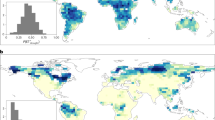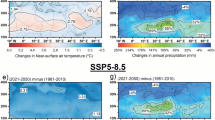Abstract
There is growing concern that the higher temperatures expected with climate change will exacerbate drought extent, duration and severity by enhancing evaporative demand. Temperature-based estimates of potential evapotranspiration (PET) are popular for many eminently practical reasons and have served well in many research and management settings. However, a number of recent publications have questioned whether it is appropriate to use temperature-based PET estimates for long-term evaporative demand and drought projections, demonstrating that PET does not always track temperature. Where precipitation changes are modest, methodologically driven differences in the magnitude or direction of PET trends could lead to contrasting drought projections. Here I calculate PET by three methods (Hamon, Priestley-Taylor and Penman) and evaluate whether different techniques introduce disparities in the sign of PET change, the degree of model agreement, or the magnitude of those changes. Changes in temperature-based Hamon PET were more significantly and consistently positive than trends in PET estimated by other methods, and where methods agreed that summer PET would increase, trends in temperature-based PET were often larger in magnitude. The discrepancies in PET trends appear to derive from regional changes in incoming shortwave radiation, wind speed and humidity -- phenomena simpler equations cannot capture. Because multiple variables can influence trends in PET, it may be more justifiable to use data-intensive methods, where the source(s) of uncertainty can be identified, rather than using simpler methods that could mask important trends.








Similar content being viewed by others
References
Allen RG, Pereira LS, Raes D, Smith M (1998) Crop evapotranspiration - Guidelines for computing crop water requirements - FAO irrigation and drainage paper 56. Food and Agriculture Organization of the United Nations, Rome, 465 pp
Barnett TP, Pierce DW (2008) When will Lake Mead go dry? Water Resour Res 44, W03201. doi:10.1029/2007WR006704
Brekke LD, Kiang JE, Olson, JR, Pulwarty RS, Raff DA, Turnipseed DP, Webb RS, White KD (2009) Climate Change and Water Resources Management: A Federal Perspective. Circular 1331, U.S. Dept of the Interior, U.S. Geological Survey, 76 pp.
Burke EJ, Brown SJ, Christidis N (2006) Modeling the recent evolution of global drought and projections for the twenty-first century with the Hadley Centre climate model. J Hydrometeorol 7:1113–1125
Cook ER, Woodhouse CA, Eakin CM, Meko DM, Stahle DW (2004) Long-term aridity changes in the western United States. Science 306:1015–1018
Dai A (2011a) Drought under global warming: a review. WIREs Clim Change 2:45–65
Dai A (2011b) Characteristics and trends in various forms of the Palmer Drought Severity Index during 1900–2008. J Geophys Res 116, D12115. doi:10.1029/2010JD015541
Donohue RJ, McVicar TR, Roderick ML (2010) Assessing the ability of potential evaporation formulations to capture the dynamics in evaporative demand within a changing climate. J Hydrol 386:186–197
Federer CA, Vörösmarty C, Fekete B (1996) Intercomparison of methods for calculating potential evaporation in regional and global water balance models. Water Resour Res 32:2315–2321
Furrer R, Nychka D, Sain S (2012). Fields: Tools for Spatial Data. R Package. http://cran.r-project.org/web/packages/fields/index.html
Hamon WR (1961) Estimating potential evapotranspiration. Proc Amer Soc Civ Engrs 87:107–120
Heim RR (2002) A review of twentieth-century drought indices used in the United States. Bull Amer Meteorol Soc 83:1149–1165
Hobbins M, Wood A, Struebel D, Werner K (2012) What Drives the Variability of Evaporative Demand across the Conterminous United States? Journal Hydrometeorol 13:1195–1214
Joyce LA, Price DT, McKenney DW, Siltanen RM, Papadopol P, Lawrence K, Coulson DP (2011) High Resolution Interpolation of Climate Scenarios for the Conterminous USA and Alaska Derived from General Circulation Model Simulations. Gen. Tech. Rep. RMRS-GTR-263. Fort Collins, CO: U.S. Department of Agriculture, Forest Service, Rocky Mountain Research Station.
Kay AL, Davies NH (2008) Calculating potential evaporation from climate model data: a source of uncertainty for hydrological climate change impacts. J Hydrol 358:221–239
Keyantash J, Dracup JA (2002) The quantification of drought: an evaluation of drought indices. Bull Amer Meteorol Soc 83:1167–1180
Kingston DG, Todd MC, Taylor RG, Thompson JR, Arnell NW (2009) Uncertainty in the estimation of potential evapotranspiration under climate change. Geophys Res Lett 36:L20403. doi:10.1029/2009GL040267
Lu J, McNulty SG, Amatya DM (2005) A comparison of six potential evapotranspiration methods for regional use in the southeastern United States. J Am Water Res Assoc 41:621–633
NOAA (2012) National Climatic Data Center, State of the Climate: Wildfires for Annual 2012, published online December 2012, retrieved on January 23, 2013 from http://www.ncdc.noaa.gov/sotc/fire/.
Palmer WC (1965) Meteorological drought. U.S. Weather Bureau Res Pap No 45.
Penman HL (1948) Natural evaporation from open water, bare soil and grass. Proc R Soc London A 193:120–145
Pierce D (2011) ncdf: Interface to Unidata netCDF data files. R Package. http://cran.r-project.org/web/packages/ncdf/index.html
Priestley CHB, Taylor RJ (1972) On the assessment of surface heat flux and evaporation using large-scale parameters. Mon Wea Rev 100:81–92
Pulwarty R (2003) Climate and water in the West: science, information and decision-making. Water Resources Update 124:4–12
Rawlins MA, Lammers RB, Frolking S, Fekete BM, Vorosmarty CJ (2003) Simulating pan-Arctic runoff with a macro-scale terrestrial water balance model. Hydrol Process 17:2521–2539
Shaw SB, Riha SJ (2011) Assessing temperature-based PET equations under a changing climate in temperate, deciduous forests. Hydrol Process 25:1466–1478
Sheffield J, Wood EF, Roderick ML (2012) Little change in global drought over the past 60 years. Nature 491:435–438
Shuttleworth WJ (2007) Putting the ‘vap’ into evaporation. Hydrol Earth Syst Sci 11:1–35
Tabor K, Williams JW (2010) Globally downscaled climate projections for assessing the conservation impacts of climate change. Ecol Appl 20:554–565
Tebaldi C, Arblaster JM, Knutti R (2011) Mapping model agreement on future climate projections. Geophys Res Lett 38, L23701. doi:10.1029/2011GL049863
Vicente-Serrano SM, Beguría L-MJI (2010) A multiscalar drought index sensitive to global warming: the standardized precipitation evapotranspiration index. J Climate 23:1696–1718
Wallace JM, Hobbs PV (2006) Atmospheric science: an introductory survey. Vol. 92. Academic Press.
Wang T, Hamann A, Spittlehouse DL, Murdock TQ (2012) Climate WNA – High-resolution spatial climate data for western North America. J Appl Meteor Climatol 51:16–29
Wehner M, Eastrling DR, Lawrimore JH, Heim RR Jr, Vose RS, Santer BD (2011) Projections of future drought in the continental United States and Mexico. J Hydrometeorol 12:1359–1377
Westerling AL, Gershunov A, Brown TJ, Cayan DR, Dettinger MD (2003) Climate and wildfire in the western United States. Bull Amer Meteor Soc 84:595–604
Wild M (2009) Global dimming and brightening: A review. J Geophys Res 114:D00D16. doi:10.1029/2008JD011470
Wilson J (2013) U.S. Crop-insurance claims rise to record after 2012 drought. Bloomberg.com. http://www.bloomberg.com/news/2013-01-15/u-s-crop-insurance-claims-rise-to-record-after-2012-drought-2-.html 15 Jan 2013 accessed 21 January 2013
WMO (2008) Guide to meteorological instruments and methods of observation, 7th edition. WMO- No.8
Acknowledgements
I would like to thank John Walsh, Scott Rupp and three anonymous reviewers for helpful comments on the manuscript. This research was performed while the author was a postdoctoral fellow funded by the USGS Alaska Climate Science Center.
Author information
Authors and Affiliations
Corresponding author
Electronic supplementary materials
Below is the link to the electronic supplementary material.
Supp Fig 1
Comparison of changes in Priestley-Taylor and Penman potential evapotranspiration in terms of statistical significance, sign and consistency between models. White areas indicate qualitative agreement between methods. Pale yellow denotes areas where one method does not show a consistent statistically significant change, and the other method suggests a statistically significant change in at least half of the models. Gold shading represents areas where one method shows no consistent statistically significant change, while the other suggests that there is a statistically significant change, but that models disagree about the sign of that change. Orange areas indicate that one method finds a statistically significant change with a high degree of model agreement, and the other method a statistically significant change, but model disagreement. Red denotes areas where the two methods find robust and statistically significant trends of opposite signs. (JPEG 132 kb)
ESM 1
High resolution image (TIFF 2349 kb)
Supp Fig 2
Change in Priestley-Taylor potential evapotranspiration (PET) minus the change in Penman PET (mm day-1) where at least five models show a statistically significant (p ≤ 0.05) increase in PET by both methods. Stippling indicates that the values are significantly different (p ≤ 0.05). White areas denote that fewer than five models showed a statistically significant change in PET by both methods. (JPEG 144 kb)
ESM 2
High resolution image (TIFF 2980 kb)
Supp Fig 3
Changes in cloud cover (%) between 2002-2011 and 2079–2098 under the A1B scenario. Colors show the mean change in cloud cover across all models. Stippling indicates that at least 80 % of the models projecting a significant (p ≤ 0.05) change agree in sign. White areas indicate that although at least half of the models project a significant change in cloud cover, they do not agree on the direction of change. Lack of stippling over colored areas of the map indicated that less than 50 % of models projected a significant change in cloud cover. (JPEG 154 kb)
ESM 3
High resolution image (TIFF 3318 kb)
Supp Fig 4
As in Supp Fig 3, but for vapor pressure deficit (kPa) (JPEG 139 kb)
ESM 4
High resolution image (TIFF 3165 kb)
Supp Fig 5
As in Supp Fig 3, but for Thornthwaite PET (mm day-1) (JPEG 134 kb)
ESM 5
High resolution image (TIFF 3611 kb)
Supp Fig 6
As in Supp Fig 3, but for Oudin PET (mm day-1) (JPEG 115 kb)
ESM 6
High resolution image (TIFF 2950 kb)
Supp Fig 7
Number of models (out of 17) indicating a statistically significant (p ≤ 0.05) decreased in Priestley-Taylor PET. (JPEG 113 kb)
ESM 7
High resolution image (TIFF 3634 kb)
Supp Fig 8
As in Supp Fig 7, but for Penman PET. (JPEG 89 kb)
ESM 8
High resolution image (TIFF 3437 kb)
Supp Fig 9
As in Supp Fig 7, but for Hamon PET (JPEG 122 kb)
ESM 9
High resolution image (TIFF 2085 kb)
ESM 10
(DOCX 66 kb)
Rights and permissions
About this article
Cite this article
McAfee, S.A. Methodological differences in projected potential evapotranspiration. Climatic Change 120, 915–930 (2013). https://doi.org/10.1007/s10584-013-0864-7
Received:
Accepted:
Published:
Issue Date:
DOI: https://doi.org/10.1007/s10584-013-0864-7




